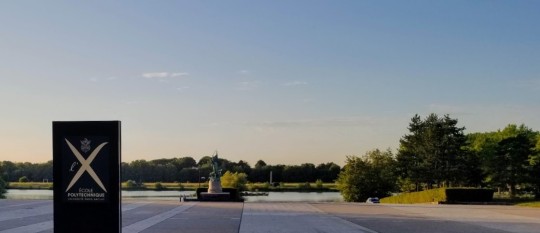by Ashlee-Ann Pigford
This past summer I had the opportunity to attend the 41st R & D Management Conference hosted by École Polytechnique and HEC in Paris, France. The theme of the conference was The Innovation Challenge: Bridging Research, Industry and Society.

The conference took place at the beautiful École Polytechnique just outside of Paris
Considering it’s a conference that largely attracts academics from business schools as well as R & D experts working in the private sector, it might come as a surprise to you that most discussions I took part in involved ecosystem evolution, adaptation, feedback loops and lifecycles. I attended talks on the evolution of ecosystems of different sizes, methods to measure the health of an ecosystem and the repercussions of disruptive events (i.e. the addition or removal of an ecosystem component). As a researcher in a natural resource science department, these presentations were a little unusual for me since they didn’t discuss nature-focused ecosystems, and rather covered human-centered (and at times even machine-centered) ecosystems.

What are human-centered ecosystems, you ask? Just like in natural ecosystems, human-centered ‘innovation ecosystems’ include both living and non-living components that interact with each other. Innovation ecosystems often include networks of interconnected actors (e.g. universities, governments, private sector, civil society) and resources (e.g. money, technology, physical spaces) that work together to achieve a common goal. Within these ecosystems, complex interactions arise as a result of either proximity, mobility or other power dynamics. I received a QCBS excellence award to present my doctoral research in a session on the design of innovation ecosystems. I shared research on the evolution of a Canadian arctic research network, which examines the impacts of climate change on the coastal Canadian Arctic. My presentation argued that if we can better understand the arctic ‘innovation ecosystem’, then we can more effectively design innovative governance approaches that may help address climate change related issues in the arctic (e.g. biodiversity protection, water management and community adaptation).

If you’re curious about the idea of machine-centered ecosystems I previously mentioned, conference sessions also covered topics related to online platforms, automation, robotics and Industry 4.0 – which is when “machines are augmented with wireless connectivity and sensors, connected to a system that can visualise the entire production line and make decisions on its own” as defined on Wikipedia. Although I attended more sessions on human-centered innovation ecosystems, I left the conference intrigued by how ecosystem principles have been applied within automation.

The rise of big data and Industry 4.0
Despite the fact that attending a conference that covers topics outside of your normal field can be a little nerve-wracking (since I study research networks that address climate change in the Arctic), I highly recommend it! I had the opportunity to network with a wide range of scholars who provided me with novel insights on my own research. I also expanded my understanding of what might constitute an ecosystem and I came back with a greater appreciation of the diversity of ecosystem conceptualizations. Ultimately, I’m left wondering – is there anything about ecosystems that biologists and ecologists might be able to learn from management scholars?

Who goes to Paris without playing tourist?

Ashlee-Ann Pigford is a PhD Candidate in the Department of Natural Resource Sciences at McGill University studying with Prof. Gordon Hickey (Sustainable Futures Laboratory, McGill University) and Prof. Laurens Klerkx (Knowledge, Technology and Innovation Group, Wageningen University). Her doctoral research aims to explore Arctic innovation ecosystems in response to repeated calls to better link research and policy processes in northern Canada. More specifically, she is interested in understanding the ways that multi-stakeholder Arctic research networks generate science that creates public value.

0 Comments